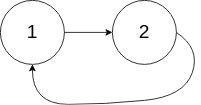环形链表
141. Linked List Cycle
Given head, the head of a linked list, determine if the linked list has a cycle in it.
There is a cycle in a linked list if there is some node in the list that can be reached again by continuously following the next pointer. Internally, pos is used to denote the index of the node that tail's next pointer is connected to. Note that pos is not passed as a parameter.
Return true if there is a cycle in the linked list. Otherwise, return false.
Example 1:

Input: head = [3,2,0,-4], pos = 1
Output: true
Explanation: There is a cycle in the linked list, where the tail connects to the 1st node (0-indexed).
Example 2:

Input: head = [1,2], pos = 0
Output: true
Explanation: There is a cycle in the linked list, where the tail connects to the 0th node.
Example 3:

Input: head = [1], pos = -1
Output: false
Explanation: There is no cycle in the linked list.
Constraints:
- The number of the nodes in the list is in the range
[0, 104]. -10^5 <= Node.val <= 10^5posis-1or a valid index in the linked-list.
Follow up: Can you solve it using O(1) (i.e. constant) memory?
思路
双指针,快指针比慢指针速度快一倍,有环则两者相遇,无环则自动跳出循环
C++解法
/**
* Definition for singly-linked list.
* struct ListNode {
* int val;
* ListNode *next;
* ListNode(int x) : val(x), next(NULL) {}
* };
*/
class Solution {
public:
bool hasCycle(ListNode *head) {
if(head == NULL || head->next == NULL)
return false;
ListNode* slow = head;
ListNode* fast = head;
while(fast && fast->next){
slow = slow->next;
fast = fast->next->next;
if(slow == fast)
return true;
}
return false;
}
};
142. Linked List Cycle II
Given the head of a linked list, return the node where the cycle begins. If there is no cycle, return null.
There is a cycle in a linked list if there is some node in the list that can be reached again by continuously following the next pointer. Internally, pos is used to denote the index of the node that tail's next pointer is connected to (0-indexed). It is -1 if there is no cycle. Note that pos is not passed as a parameter.
Do not modify the linked list.
Example 1:

Input: head = [3,2,0,-4], pos = 1
Output: tail connects to node index 1
Explanation: There is a cycle in the linked list, where tail connects to the second node.
Example 2:

Input: head = [1,2], pos = 0
Output: tail connects to node index 0
Explanation: There is a cycle in the linked list, where tail connects to the first node.
Example 3:

Input: head = [1], pos = -1
Output: no cycle
Explanation: There is no cycle in the linked list.
Constraints:
- The number of the nodes in the list is in the range
[0, 10^4]. -10^5 <= Node.val <= 10^5posis-1or a valid index in the linked-list.
Follow up: Can you solve it using O(1) (i.e. constant) memory?
思路
快慢指针相遇,相遇后新增一个指针ptr,由于距离关系,slow指针到环入口的距离与头指针相等,ptr和slow相遇处即为环入口。
Time Complexity: O(N)
Space Complexity: O(1)
C++解法
/**
* Definition for singly-linked list.
* struct ListNode {
* int val;
* ListNode *next;
* ListNode(int x) : val(x), next(NULL) {}
* };
*/
class Solution {
public:
ListNode *detectCycle(ListNode *head) {
if(head == NULL || head->next == NULL)
return NULL;
ListNode* slow = head;
ListNode* fast = head;
while(fast && fast->next){
slow = slow->next;
fast = fast->next->next;
if(slow == fast){
ListNode* ptr = head;
while(ptr != slow){
ptr = ptr->next;
slow = slow->next;
}
return ptr;
}
}
return NULL;
}
};
Java解法
public class Solution {
public ListNode detectCycle(ListNode head) {
ListNode slow = head, fast = head;
while (fast != null && fast.next != null) {
slow = slow.next;
fast = fast.next.next;
if (slow == fast) break;
}
if (fast == null || fast.next == null) return null;
while (head != slow) {
head = head.next;
slow = slow.next;
}
return head;
}
}
Python解法
class Solution(object):
def detectCycle(self, head):
slow = fast = head
while fast and fast.next:
slow, fast = slow.next, fast.next.next
if slow == fast: break
else: return None # if not (fast and fast.next): return None
while head != slow:
head, slow = head.next, slow.next
return head